Mendel’s experiments on pea plants are among the most important ever conducted in the history of biology. It is not as widely known, however, that Mendel also experimented on another plant, Hieracium, or “hawkweed.” And, as it turned out, he couldn’t confirm the results he’d had with pea plants. So he argued that in nature there must be some other type of heredity different from that seen in pea plants, which he dubbed “Hieracium-type” heredity.
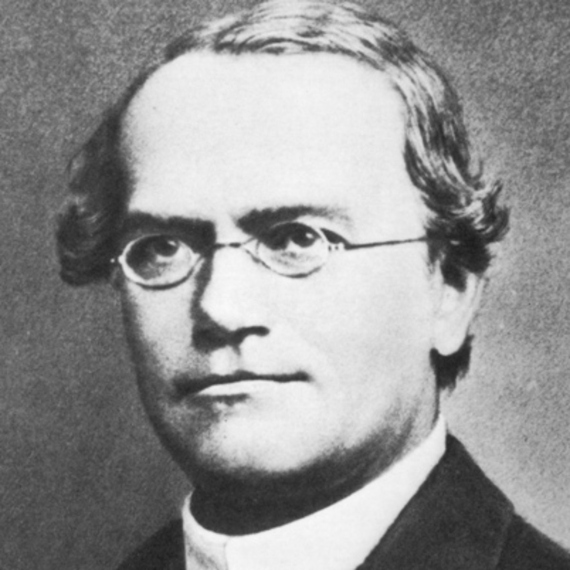
What does this second type of heredity involve? How does it differ from the heredity pattern seen in pea plants? Is it frequent in nature or is it an isolated case?
HAWKWEED “FAILED” MENDEL
To find out whether the rules of heredity he had observed in pea plants were fulfilled more widely, Gregor Mendel (July 20, 1822—January 6, 1884) crossed other plants with one another. He also conducted some preliminary experiments on animals such as mice and bees. In more than twenty plant species on which he performed experiments like those on the pea plant—fertilizing the flowers of one variety with the pollen of another variety—he found that the rules he had seen in the pea plant continued to hold true. Except in one species: hawkweed. It is a genus of the daisy family, Asteraceae. It was so named because in ancient times it was believed to be eaten by hawks to strengthen their vision—this is what Pliny the Elder wrote, for instance. Hierax means “hawk” in Greek. And in English the plant is of course known as “hawkweed.”
In his experiments on hawkweed, Mendel found that neither the first rule nor the second rule he had observed in the pea plant held true. According to the first rule, first-generation hybrids bred by crossing two different varieties of pea plant—or other plants—are uniform in appearance, since they all display the trait of one of the parental varieties. But the first generation of hybrids in hawkweed was not uniform in appearance. Mendel observed that many of the plants resembled the variety that had functioned as pollen recipient, others resembled the pollen donor, and there were even a few in between.
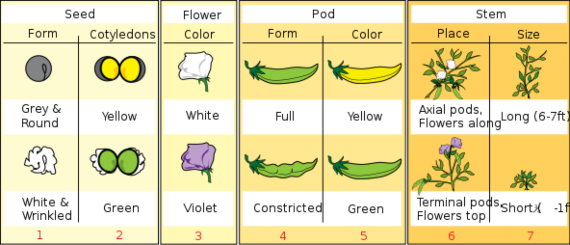
The seven traits observed by Gregor Mendel in his genetic experiments with pea plants. Source: Wikimedia
The second pea-plant rule is that, in the second generation bred from hybrids, plants resembling the first generation reappear, but in a 3:1 ratio with respect to plants resembling the founding variety that did not appear in the first generation. In hawkweed, this rule was not fulfilled, either. This was the second rule or “law,” the law of segregation of variants—or alleles, as they would later become known—existing within the genes. But in hawkweed, however, the second generation plants were uniform in appearance, and there was no segregation.
Mendel published his findings a few years after his observations on pea plants (the pea plant paper came out in 1865-66, while the hawkweed paper was published in 1869-70). As he could not confirm in hawkweed the rules he had deduced from peas and other plants, he argued that in nature there must be two types of heredity: the pea-plant type and the hawkweed type, and both must be expressions of a more general phenomenon. But he went no further. Perhaps his failing eyesight, and then his appointment as abbot of the Augustinian monastery where he was a friar, discouraged him from continuing his inquiries.
REDISCOVERY AND EXPLANATION OF THE HAWKWEED ENIGMA
Mendel’s experiments and ideas were consigned to oblivion for more than 30 years. And when in 1900 they were rediscovered independently by Correns, Tschermark, and de Vries—with pea experiments again featuring prominently—they realized that the rules originally deduced by Mendel were also fulfilled in several animal and plant species. Therefore, they were accorded the status of “laws.”
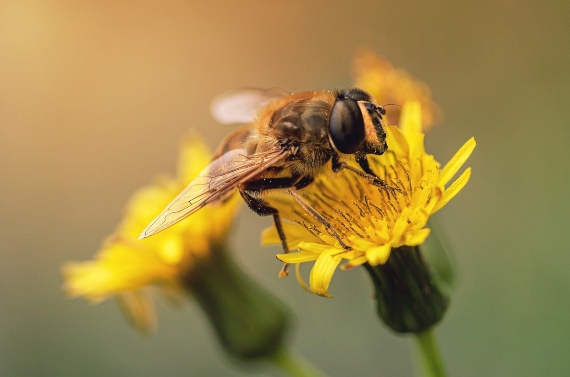
Some of these later researchers dusted off Mendel’s paper on the hawkweed experiments but did not believe the findings could be significant because they were so hard to explain. However, some time later, the mystery of why hawkwood refuses to follow Mendel’s laws began to be cleared up. From 1904 to 1910, two researchers, Ostenfeld and Rosenberg, worked on hawkweed, and even repeated Mendel’s earlier experiments. And they observed that Hieracium is a genus of plants in which some species reproduce by the normal sexual process. Seeds are formed by a fusion of male and female gametes, as Mendel had seen in all the plants he had investigated. This is the default form of reproduction in nature. But then there are other species of the Hieracium genus that reproduce wholly or partially asexually, by a phenomenon whereby seeds develop from either non-reproductive somatic cells close to female gametes, or from female gametes that do not need to be fertilized by male gametes. These seeds and plants are effectively clones of the female parent. The phenomenon is termed “apomixis” (from the Greek apo, “lack,” and mixis, “mingling”). And the hawkweed plants that Mendel chose for his experiments happened to be totally or partly apomictic.
The absence of male gametes in the formation of seeds explains why, for example, unlike the case with peas, Mendel’s first generation of hybrids in hawkweed was not uniform. Many of the hybrids inherited the traits of the female parents selected by Mendel, which were those involved in seed formation by apomixis. And hybrids displaying traits of male parents or a mixture of both parents were formed by “normal” sexual reproduction.
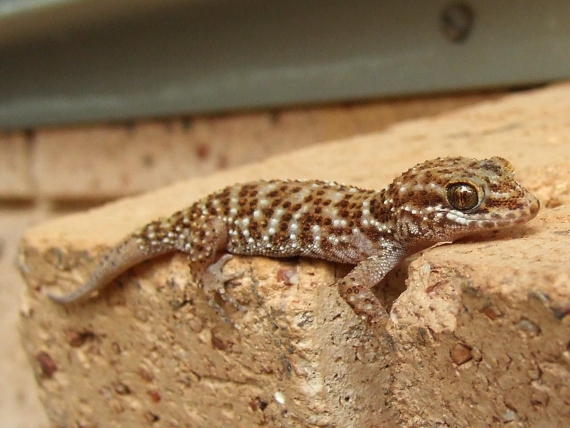
What we might call Hieracium-type heredity is due to the fact that two kinds of seeds and plants are formed. One kind originates from sexual reproduction, involving male and female gametes. While a second kind of seeds and plants originates by asexual reproduction, from female gametes alone or from somatic cells. The former kind follows Mendel’s laws while the latter does not. The production of both kinds of hawkweed seeds and plants in the crosses conducted by Mendel meant that, overall, Hieracium did not follow the canonical laws of heredity.
But is this type of heredity common in nature?
HIERACIUM-TYPE HEREDITY IN NATURE
After Mendel and the researchers who rediscovered his ideas, it has been seen that Hieracium-type heredity is a rare but widespread phenomenon in nature. It occurs in many plants of the Compositae family: for example, in the dandelion genus, Taraxacum. And it is also frequent in plants of the Rosaceae, such as blackberries, Rubus. Overall, this phenomenon has been found in about 50 families and 150 genera of plants.
For animals, apomixis is termed parthenogenesis (from the Greek parthenos, “virgin,” and genesis, “creation”). And it happens in worms and insects, reptiles and birds, and fish and amphibians. It is common in some species of lizards and fish, for instance. In birds, cases have been observed in natural populations when females do not have access to male mates. Very recently, a case was reported of several female condors that produced parthenogenetic offspring in captivity despite the availability of males. In mammals, parthenogenesis has not been observed in the wild, but it has been experimentally achieved in mice and rabbits.
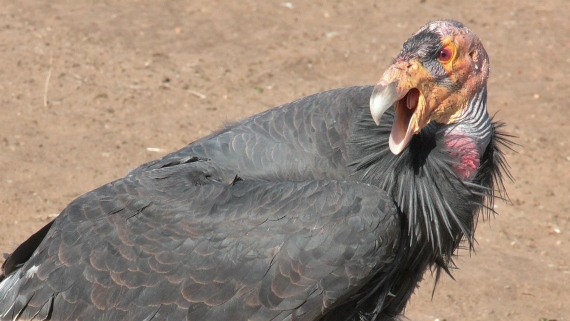
In the end, therefore, Mendel was right to conclude that Hieracium, or hawkweed, is an interesting exception to the rules of heredity he had observed in the pea and other plants. It was later discovered that the exception was due to hawkweed’s special mode of reproduction: a mixture of “normal” sexual reproduction and a form of asexual reproduction. It is now known, moreover, that in nature there are a wide range of animals and plants that display this special type of heredity.
Manuel Rejón
Professor of Genetics at the Universities of Granada and Autónoma de Madrid
Comments on this publication